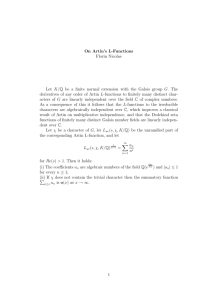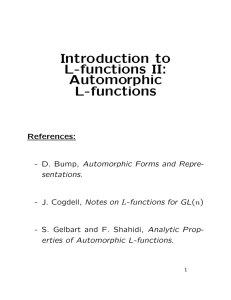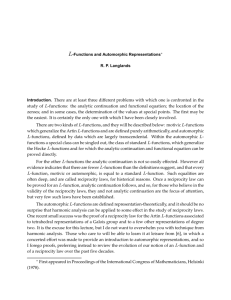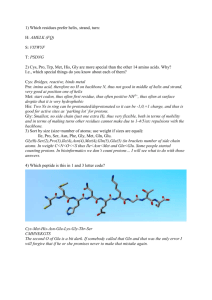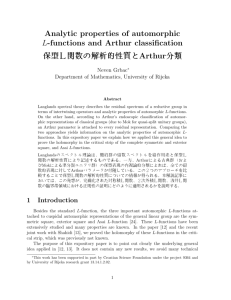I. An overview of the theory of Zeta functions and L
advertisement
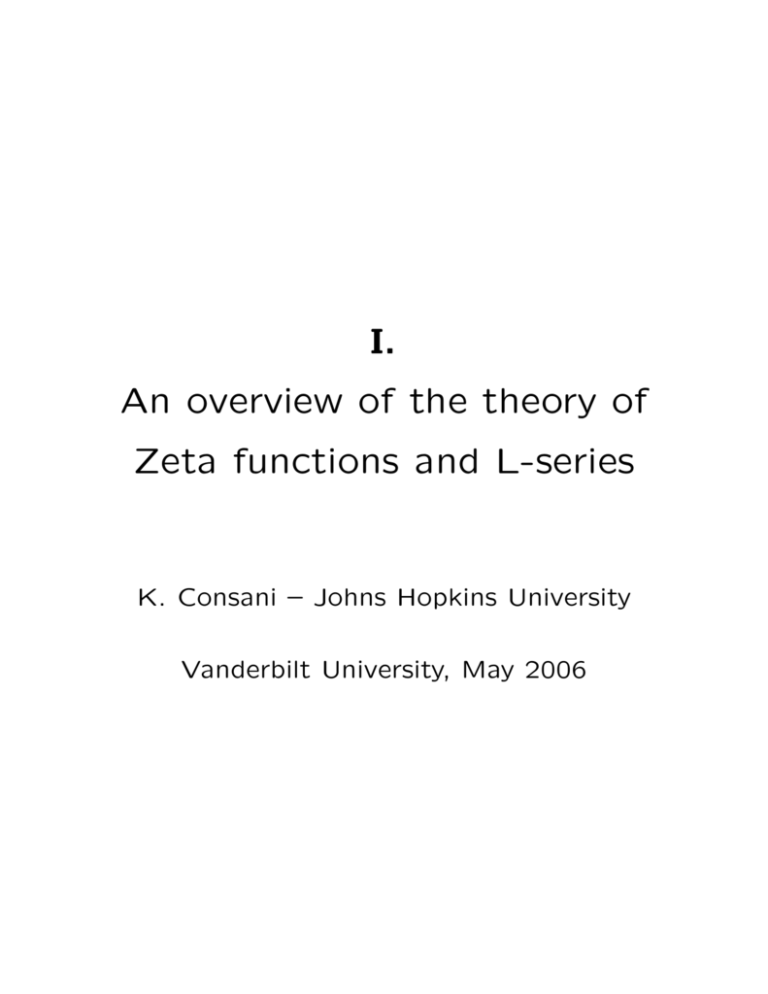
I.
An overview of the theory of
Zeta functions and L-series
K. Consani – Johns Hopkins University
Vanderbilt University, May 2006
(a) Arithmetic L-functions
(a1) Riemann zeta function:
(a2) Dirichlet L-series:
ζ(s),
s∈C
L(χ, s)
χ : (Z/mZ)× → S 1 = {z ∈ C | |z| = 1}
(a3) Dedekind zeta funct:
(a4) Hecke L-series:
ζK (s), [K : Q] ≤ ∞
LK (χ, s)
(a5) Artin L-function:
L(ρ, s)
ρ : Gal(K/Q) → GLn (C)
(a6) Motivic L-function:
Galois representation
L(M, s)
M pure or mixed motive
1
(b) Automorphic L-functions
(b1) Classical theory
L(f, s); L(f, χ, s)
(before Tate’s thesis 1950)
modular L-function
associated to a modular cusp form
(b2) Modern adelic theory:
f :H→C
L(π, s)
automorphic L-function
π = ⊗0v πv ,
(πv , Vπv ) = irreducible (admissible)
representation of GLn (Qv )
2
(a1) The Riemann zeta function
∞
X
1
ζ(s) :=
s
n=1 n
s ∈ C,
Main Facts
• converges absolutely and uniformly on Re(s) > 1
P∞ 1
P∞
1
(Re(s) ≥ 1 + δ (δ > 0),
|
|
≤
n=1 ns
n=1 n1+δ )
⇒ ζ(s) represents an analytic function in Re(s) > 1
• Euler’s identity:
ζ(s) =
Y
(1 − p−s)−1
p
prime
(|
Q
−s −1 − ζ(s)| ≤
p≤N (1 − p )
P
1
n>N n1+δ )
Number-theoretic significance of the zeta-function:
I Euler’s identity expresses the law of unique prime
factorization of natural numbers
3
Γ(s) :=
Z ∞
0
s ∈ C,
e−y y s
dy
y
Re(s) > 0;
Gamma-function
absolutely convergent
• Γ(s) analytic, has meromorphic continuation to C
•
Γ(s) 6= 0, has simple poles at
s = −n, n ∈ Z≥0
Ress=−n Γ(s) =
•
functional equations
Γ(s + 1) = sΓ(s),
•
Γ(s)Γ(1 − s) =
π
sin(πs)
Legendre’s duplication formula
Γ(s)Γ(s +
•
(−1)n
n!
1
)
2
=
√
2 π
Γ(2s)
22s
special values
Γ( 12 ) =
√
π,
Γ(1) = 1,
Γ(k + 1) = k!,
k ∈ Z≥0
4
The connection between Γ(s) and ζ(s)
Z
y 7→
πn2 y
⇒
π −s Γ(s) n12s
∞
=
e−πn y y s
2
0
dy
y
sum over n ∈ N
Z
π −s Γ(s)ζ(2s)
=
0
Θ(z) :=
X
∞X
−πn2 y s dy
e
y
n≥1
eπin z = 1 + 2
2
∞
X
y
g(y) :=
X
e−πn y
2
n≥1
eπin z
2
Jacobi’s theta
n=1
n∈Z
g(y) = 12 (Θ(iy) − 1),
s
Z(s) := π − 2 Γ( 2s )ζ(s)
Main Facts
(1)
Z(s) admits the integral representation
Z ∞
dy
Mellin Principle
(Θ(iy) − 1)y s/2
Z(s) = 12
⇒
y
0
(2) Z(s) admits an analytic continuation to
C \ {0, 1}, has simple poles at s = 0, s = 1
Ress=0 Z(s) = −1,
Ress=1 Z(s) = 1
5
(3) functional eq
Z(s) = Z(1 − s)
Implications for the Riemann zeta ζ(s)
(4) ζ(s) admits an analytic continuation to C \ {1}
has simple pole at s = 1,
(5) (functional eq)
Moreover,
Ress=1 ζ(s) = 1
ζ(1 − s) = 2(2π)−s Γ(s) cos( πs
)ζ(s)
2
from Z(s) = Z(1 − s)
⇒
I the only zeroes of ζ(s) in Re(s) < 0 are the poles of
Γ( 2s ) (s ∈ 2Z<0 , “trivial zeroes”)
I other zeroes of ζ(s) (i.e. on Re(s) > 0) must lie on
the critical strip: 0 ≤ Re(s) ≤ 1
Riemann Hypothesis The “non-trivial” zeroes of
ζ(s) lie on the line
Re(s) =
1
2
6
(a2)
m ∈ N,
Dirichlet L-series
χ : (Z/mZ)∗ → S 1 = {z ∈ C : |z| = 1}
Dirichlet character mod.m
½
χ : Z → C,
s ∈ C,
χ(n) =
χ(n mod m)
0
X χ(n)
L(χ, s) :=
s
n≥1 n
for χ = 1 (principal character):
(n, m) = 1
(n, m) 6= 1
Re(s) > 1
L(1, s) = ζ(s)
Main Facts
(1) Euler’s identity:
Y
L(χ, s) =
(1 − χ(p)p−s )−1
p
(2) L(χ, s) converges absolutely and unif. on Re(s) > 1
(represents an analytic function)
7
χ(−1) = (−1)p χ(1),
p ∈ {0, 1} exponent
χ : {(n) ⊂ Z | (n, m) = 1} → S 1
n p
χ((n)) := χ(n)( |n|
)
Grössencharacter mod.m
Z
Γ(χ, s) :=
Γ( s+p
)
2
∞
=
(multiplicative fct)
e−y y (s+p)/2
0
y 7→ πn2 y/m,
θ(χ, iy) =
s
) 2 Γ(χ, s)
L∞ (χ, s) := ( m
π
P
dy
Gamma integral
y
p −πn2 y/m
n χ(n)n e
... ⇒
archimedean Euler factor
Λ(χ, s) := L∞(χ, s)L(χ, s),
Re(s) > 1
completed L-series of the character χ
Λ(χ, s) has integral representation
• Functional eq.:
Mellin principle
⇒
If χ 6= 1 is a primitive character,
Λ(χ, s) admits an analytic continuation to C and
satisfies the functional equation
Λ(χ, s) = W (χ)Λ(χ̄, 1 − s),
|W (χ)| = 1
(χ̄ = complex conjugate character)
8
(a3)
Dedekind zeta function
K/Q number field,
[K : Q] = n
X
1
ζK (s) :=
s
N
(
a
)
a⊂OK
s∈C
a = integral ideal of K,
N (a) = absolute norm
Main Facts
(1) ζK (s) converges absolutely and unif. on Re(s) > 1
(2) (Euler’s identity)
Y
ζK (s) =
(1 − N (p)−s )−1
Re(s) > 1
p
ClK = J/P
ζK (s) =
X
[b]∈ClK
ζ(b, s)
ideal class group of K
ζ(b, s),
ζ(b, s) :=
X
a∈[b]
integral
1
N (a)s
partial zeta functions
9
LR(s) := π −s/2Γ(s/2)
LC(s) := 2(2π)−sΓ(s)
r1 := number of real embeddings
v = v̄ : K → C
r2 := number of pairs of complex embeddings
{v, v̄} : K → C
dK = discriminant of K
Z∞(s) := |dK |s/2LR(s)r1 LC(s)r2
Euler’s factor at infinity of ζ(b, s)
I Z(b, s) := Z∞(s)ζ(b, s),
Re(s) > 1
admits an analytic continuation to C \ {0, 1}
and satisfies a functional equation
ZK (s) :=
X
Z(b, s) = Z∞ (s)ζK (s)
b
From the corresponding properties of Z(b, s) one
deduces
10
Main Facts
(1) ZK (s) = Z∞(s)ζK (s) has analytic continuation to
C \ {0, 1}
(2) (functional eq)
ZK (s) = ZK (1 − s)
ZK (s) has simple poles at s = 0, 1
Ress=0 ZK (s) = − 2 whR ,
r
Ress=1 ZK (s) =
2r hR
w
r = r1 + 2r2 , h = class nb. of K, R = regulator of K
w = number of roots of 1 in K
[Hecke] Subsequent results for ζK (s)
(3) ζK (s) has analytic continuation to C \ {1}
with a simple pole at s = 1
(4) Class number formula
1
2
Ress=1 ζK (s) = 2 √(2π) hR
w
r
r
|dK |
11
(5) (functional eq.)
ζK (1 − s) = A(s)ζK (s)
A(s) := |dK |s−1/2 (cos πs
)r1+r2 (sin πs
)r2 LC (s)n
2
2
(6) ζK (s) 6= 0
for
Re(s) > 1
⇒
m ∈ Z≥0
∗ )
r1 + r2 − 1 = rk(OK
ords=−m ζK (s) = r1 + r2
r
2
if m = 0
if m > 0 even
if m > 0 odd
The class number formula reads now as
ζK (s)
hR
∗ (0) := lim
ζK
s→0 sr1 +r2 −1 = − w
12
(a5)
Artin L-functions
L/K = Galois extension of nb field K,
G := Gal(L/K)
Artin L-functions generalize the classical L-series
in the following way
L(χ, s) =
X χ(n)
n≥1
ns
Y
=
(1 − χ(p)p−s )−1 , Re(s) > 1
χ : (Z/mZ)∗ → C∗ ,
p mod m 7→ ϕp ,
p
'
G := Gal(Q(µm )/Q) ← (Z/mZ)∗
p
ϕp (ζm ) = ζm
Frobenius
χ : G → GL1 (C)
II
1-dim Galois representation
Y
L(χ, s) =
(1 − χ(ϕp )p−s )−1
p-m
this is a description of the Dirichlet L-series in a purely
Galois-theoretic fashion
More in general:
13
V = finite dim C-vector space
ρ : G = Gal(L/K) → GL(V ) = AutC (V )
p prime ideal in K, q/p prime ideal of L above p
'
Dq /Iq → Gal(κ(q)/κ(p)),
ϕq 7→ (x 7→ xq )
ϕq ∈ End(V Iq )
Dq /Iq =< ϕq >
q = N (p)
finite order endomorphism
Pp (T ) := det(1 − ϕqT ; V Iq ) ,
characteristic pol
only depends on p (not on q/p)
ζL/K (ρ, s) :=
Y
det(1 − ϕqN (p)−s ; V Iq )−1
pprime
inK
Artin L-series
det(1 − ϕq N (p)−s ;
V Iq ) =
d
Y
(1 − ²i N (p)−s )
i=1
²i = roots of 1:
ϕq has finite order
I ζL/K (ρ, s) converges absolutely and unif on Re(s) > 1
14
If (ρ, C) is the trivial representation, then
ζL/K (ρ, s) = ζK (s)
Dedekind zeta function
P 1
I An additive expression analogous to ζK (s) = a N (a)
s
does not exist for general Artin L-series.
I Artin L-series exhibit nice functorial behavior under
change of extensions L/K and representations ρ
χρ : Gal(L/K) → C
Character of (ρ, V )
χρ (σ) = tr(ρ(σ)),
χρ (1) = dim V = deg(ρ)
(ρ, V ) ∼ (ρ0 , V 0 )
ζL/K (ρ, s) = ζL/K (χρ , s);
ζL(s) = ζK (s)
⇐⇒
χρ = χρ0
functorial behavior
Y
⇒
ζL/K (χ, s)χ(1)
χ6=1
χ irred of G(L/K)
Artin conjecture ∀χ 6= 1 irreducible, ζL/K (χ, s)
defines an entire function i.e. holom. function on C
the conjecture has been proved for abelian extensions
15
For every infinite (archimedean) place p of K
½
LC (s)χ(1)
p complex
ζL/K,p (χ, s) =
LR (s)n+ LR (s + 1)n− p real
n+ =
χ(1)+χ(ϕq )
,
2
n− =
χ(1)−χ(ϕq )
;
2
ϕq ∈ Gal(Lq/Kp )
ζL/K,p (χ, s) has also nice functorial behavior
For p real, ϕq induces decomp
V =V+⊕V−
V + = {x ∈ V : ϕqx = x}, V − = {x ∈ V : ϕqx = −x}
n+ = dim V + ,
ζL/K,∞(χ, s) :=
n− = dim V −
Y
ζL/K,p (χ, s)
p|∞
s
ΛL/K (χ, s) := c(L/K, χ) 2 ζL/K (χ, s)ζL/K,∞ (χ, s)
completed Artin series
c(L/K, χ) := |dK |χ(1) N (f(L/K, χ)) ∈ N
Q
f(L/K, χ) = p-∞ fp(χ) Artin conductor of χ
fp(χ) = pf (χ) local Artin conductor
(f (χ) ∈ Z)
16
Main Facts
• ΛL/K (χ, s) admits a meromorphic continuation to C
• (Functional eq.)
ΛL/K (χ, s) = W (χ)ΛL/K (χ̄, 1 − s)
W (χ) ∈ C,
|W (χ)| = 1
I the proof of the functional equation uses the fact
that the Euler factors ζL/K,p (χ, s) at the infinite places
p behave, under change of fields and characters, in
exactly the same way as the Euler factors at the finite
places:
p<∞
ζL/K,p (χ, s) := det(1 − ϕq N (q)−s ; V Iq )−1
this uniform behavior that might seem at first in
striking contrast with the definition of the archimedean
Euler factors has been motivated by a
unified interpretation of the Euler’s factors
(archimedean and non)
II
[Deninger 1991-92, Consani 1996]
N (p)
(sid − Θp ); H(X(p)/Lp ))−1
ζL/K,p (χ, s) = det∞( log2πi
this result reaches far beyond Artin L-series and
suggests a complete analogy with the theory of
L-series of algebraic varieties over finite fields.
17
(b)
Automorphic L-functions
(b1) Classical theory (before Tate’s thesis)
f : H → C modular form of weight k for Γ ⊂ SL2 (Z)
•
µ
•
•
H = upper-half complex plane
f holomorphic,
γ=
a b
c d
¶
∈ Γ,
f ( az+b
) = (cz + d)k f (z)
cz+d
f is regular at the cusps z of Γ, |SL2(Z) : Γ| < ∞
(z ∈ Q ∪ {i∞} fixed pts of parabolic elements of Γ)
Examples
- θq (z) theta series attached to a quadratic form q(x)
θq (z) =
P∞
n=0 a(n)e
2πinz ,
a(n) = Card{v : q(v) = n}
- ∆(z) discriminant function from the theory of elliptic
modular functions
∆(z) = 2−4 (2π)12
P∞
n=1 τ (nz)e
2πinz
18
For simplicity will assume: Γ = SL2 (Z)
µ
¶
1 1
∈ Γ ⇒ f (z + 1) = f (z)
0 1
f (z) =
X
an e2πinz
Fourier expansion
n≥0
f is a cusp form if a0 = 0
f (z) =
P
i.e.
2πinz
n≥1 an e
the Fourier coefficients an often carry interesting
arithmetical information:
- f (z) = θq (z), an counts the number of times n is
represented by the quadratic form q(x)
- f (z) = ∆(z), an = τ (n) Ramanujan’s τ -function
[Hecke 1936] Attached to each cusp form there is a
complex analytic invariant function: its L-function
L(f, s) =
X an
ns
n≥1
Dirichlet series
19
L(f, s) =
X an
s
n
n≥1
This L-function is connected to f by an integral
representation: its Mellin transform
Z ∞
Λ(f, s) = (2π)−s Γ(s)L(f, s) =
f (iy)y s d×y
0
through this integral representation one gets
[Hecke] L(f, s) is entire and satisfies the functional
equation
Λ(f, s) = ik Λ(f, k − s)
the functional equation is a consequence
of¶ having a
µ
0 −1
sending
modular transformation law under
1 0
z 7→ − 1z
Since the Mellin transform has an inverse integral
transform, one gets
20
Converse theorem [Hecke]
X an
D(s) =
ns
n
If
has a “nice” behavior and satisfies the correct
functional equation (as above) then
X
f (z) =
an e2πinz
n
is a cusp form (of weight k) for SL2 (Z) and
D(s) = L(f, s)
in particular: the modularity of f (z) is a consequence
of the Fourier expansion and the functional equation
[Weil 1967] the Converse theorem for Γ0 (N ) holds,
by using the functional equation not just for L(f, s) but
also for
L(f, χ, s) =
X χ(n)an
n≥1
ns
χ = Dirichlet character of conductor prime to the
level N ∈ N
µ
¶
a b
Γ0(N ) = {
∈ SL2 (Z) : c ≡ 0 mod N }
c d
21
[Hecke 1936]
An algebra of operators
H = {Tn }
Hecke operators
acts on modular forms.
If f (z) is a simultaneous eigen-function for the
operators in H, then L(f, s) has an Euler’s product
Y
(1 − ap p−s + p−2s )−1
L(f, s) =
p
Conclusion
Arithmetic L-functions
are described by Euler’s products, analytic properties
are conjectural, arithmetic meaning is clear
Automorphic L-functions
are defined by Dirichlet series, characterized by
analytic properties, Euler’s product and arithmetic
meaning are more mysterious...
22
(b2)
Modern adelic theory
The modular form f (z) for SL2 (Z) (or congruence
subgroup) is replaced by an automorphic
representation of GL2 (A)
(in general by an automorphic representation of
GLn (A))
this construction is a generalization of Tate’s thesis for
GL1 (A)
A :=
Y0
Qp × R
ring of adèles of Q
p
locally compact topological ring (
product)
Q0
Q ⊂ A diagonal discrete embedding,
GLn (A) =
Y0
= restricted
A/Q compact
GLn (Qp ) × GLn (R)
p
GLn (Q) ⊂ GLn (A) diagonal discrete embedding
Z(A)GLn (Q)\GLn (A)
finite volume
23
GLn (A) acts on the space
A0(Z(A)GLn (Q)\GLn (A))
cusp automorphic forms
producing a decomposition:
M
A0 (GLn (Q)\GLn (A)) =
m(π)Vπ
π
the (infinite dimensional) factors are the cuspidal
automorphic representations
The decomposition of GLn (A) as a restricted product
corresponds to a decomposition of the representations
π ' ⊗0v πv = (⊗0p πp ) ⊗ π∞
(πv , Vπv ) = irreducible (admissible) representations of
GLn (Qv )
Main relations
π∞ −→ L(π∞ , s) ←→ Γ(s)
πp −→ L(πp , s) = Qp (p−s )−1
Y
π −→ Λ(π, s) =
L(πp , s)L(π∞, s) = L(π, s)L(π∞, s)
p
for Re(s) >> 0
24
Q
[Jacquet,P-S,Shalika] L(π, s) := p L(πp , s) is entire
and satisfies a functional equation
Λ(π, s) = ²(π, s)Λ(π̃, 1 − s)
[Cogdell, P-S]
A Converse theorem holds
⇒
I “nice” degree n automorphic L-functions are
modular, i.e. they are associated to a cuspidal
automorphic representation π of GLn (A)
The theory or Artin L-functions L(ρ, s) associated to
degree n representations ρ of GQ := Gal(Q̄/Q) (and
their conjectural theory) has suggested
Langlands’ Conjecture (1967)
{ρ : GQ → GLn (C)} ⊂ {π|autom.rep. of GLn (A)}
s.t.
L(ρ, s) = L(π, s)
modularity of Galois representations
25
there is a local version of this conjecture
In fact the local version (now a theorem!) can be
stated very precisely, modulo replacing the local Galois
group GQv by the (local) Weil and Deligne groups
GQv à WQv , WQ0 v
[Harris-Taylor, Henniart 1996-98] there is a 1-1
correspondence satisfying certain natural
compatibilities (e.g. compatibility with local functional
equations and preservation of L and epsilon factors of
pairs)
{ρv : WQ0 v → GLn (C) : admissible} ↔
↔ {π : irred.admiss rep of GLn (Qv )}
Conclusion:
local Galois representations are modular!
Global Modularity?
There is a global version of the Weil group WQ but
there is no definition for a global Weil-Deligne group
(the conjectural Langlands group)
At the moment there is a conjectural re-interpretation
of it: an “avatar” of this global modularity:
Global (local) functoriality...
26
BIBLIOGRAPHY
• J. Neukirch
Algebraic Number Theory,
Springer
• Manin, Panchishkin Introduction to Modern
Number Theory, Springer
27
